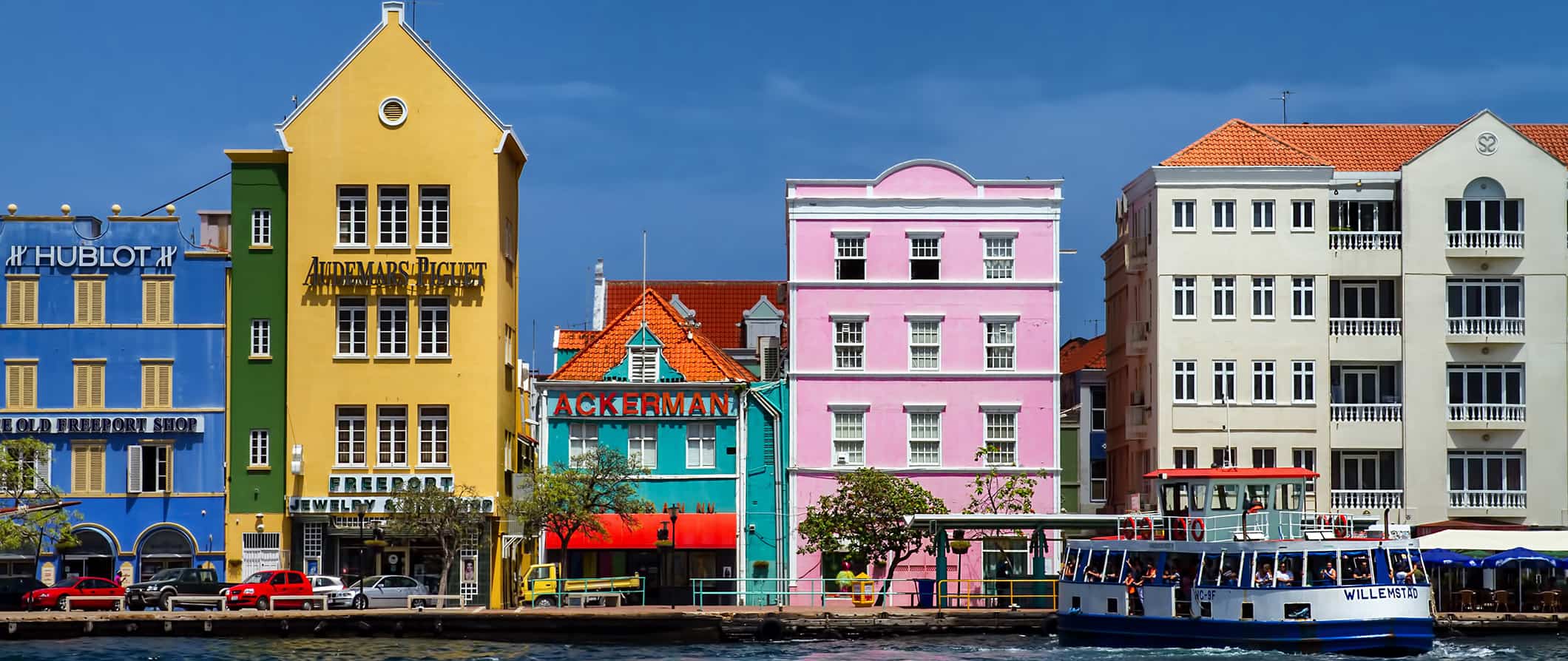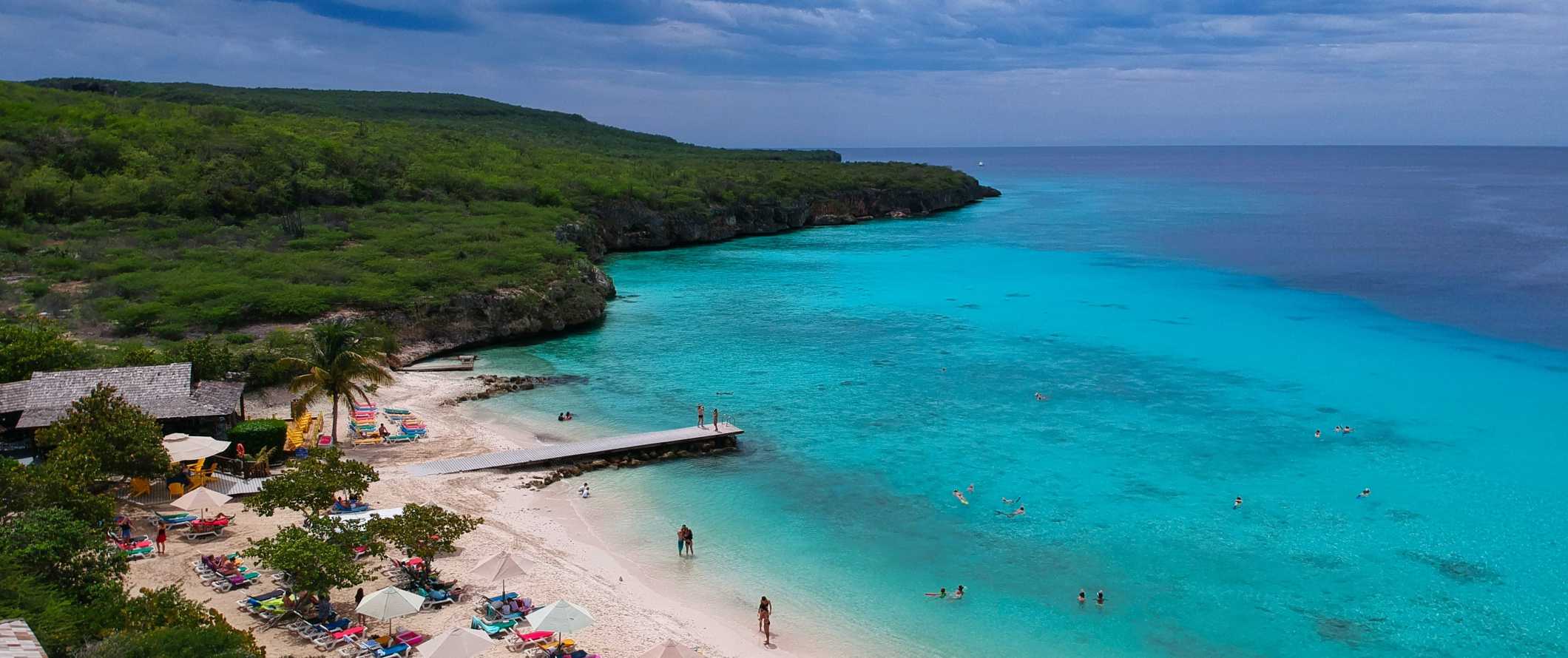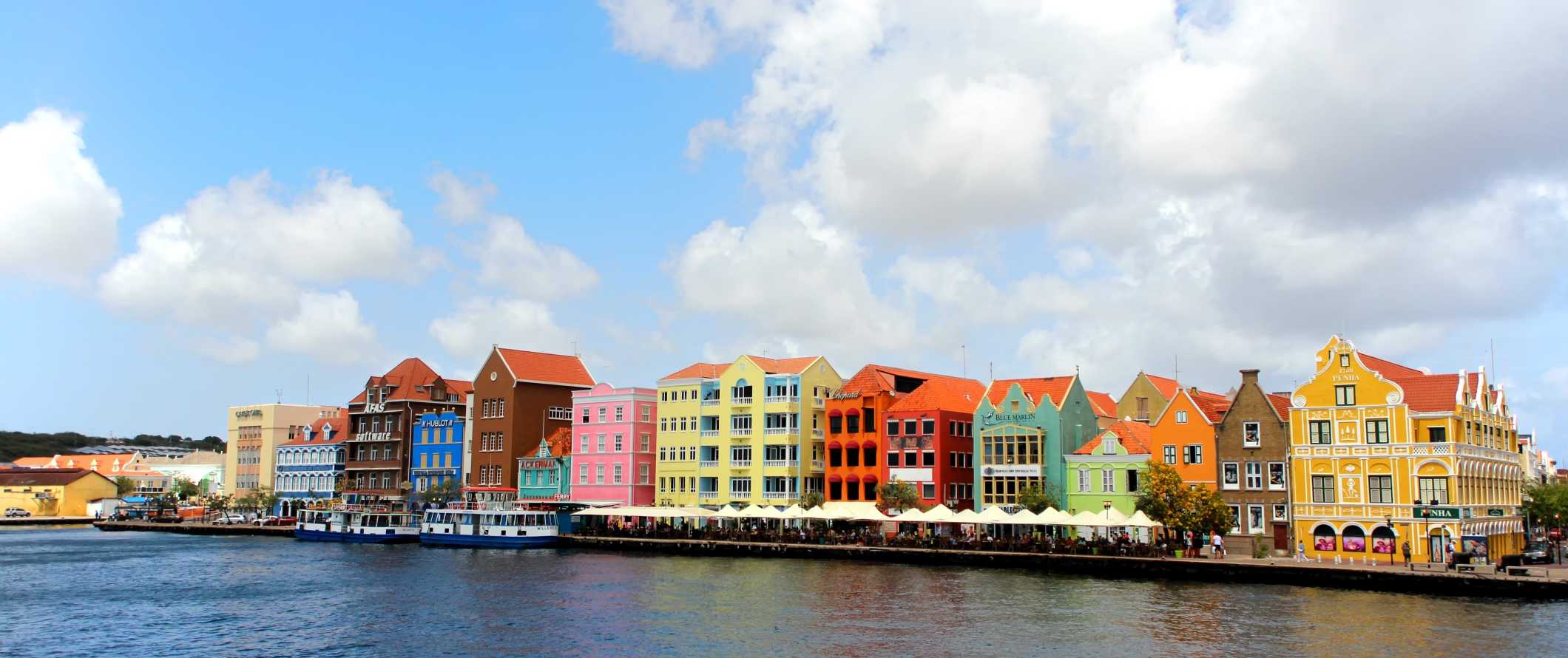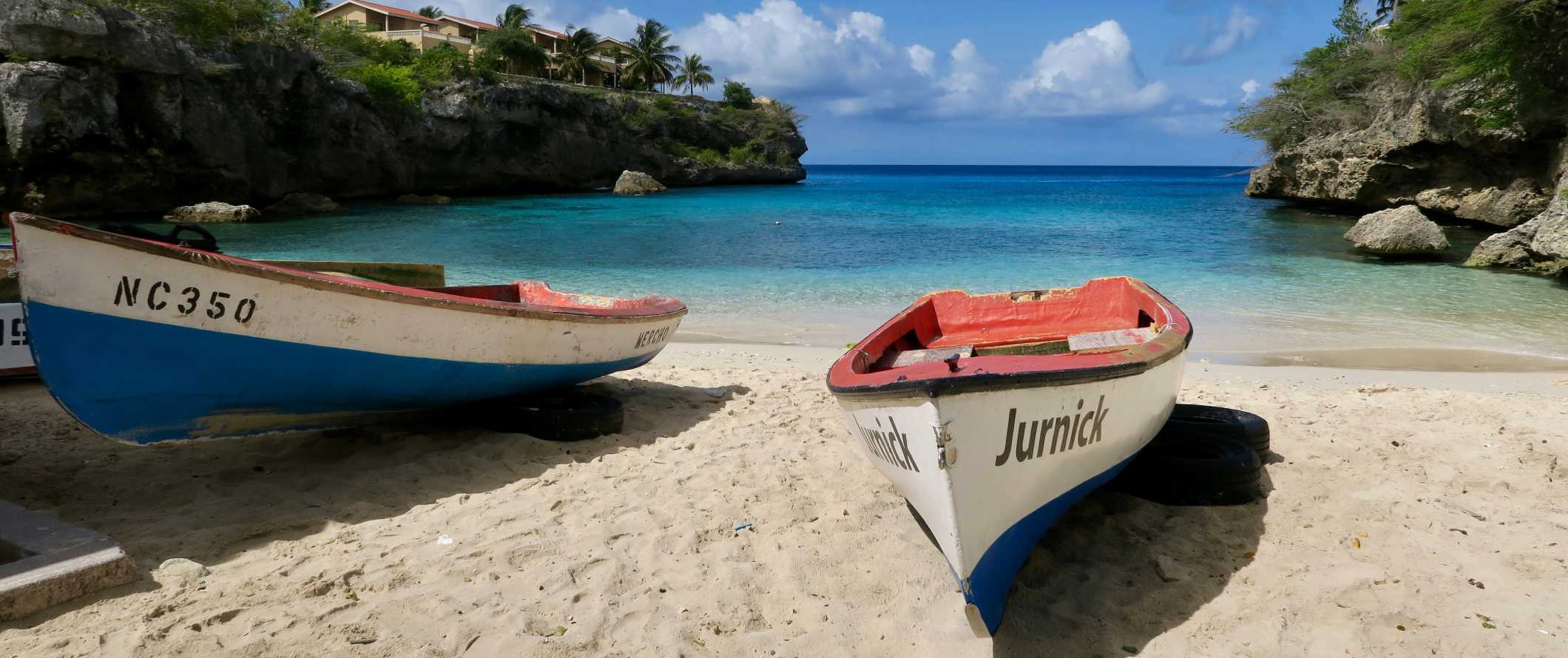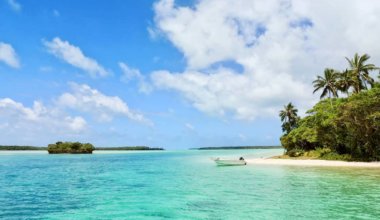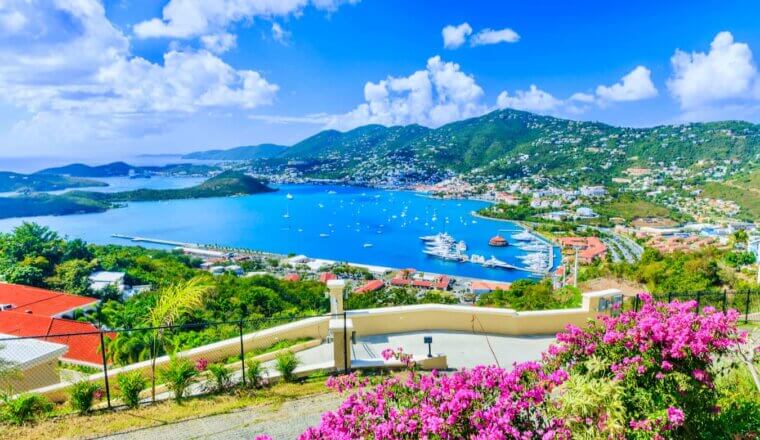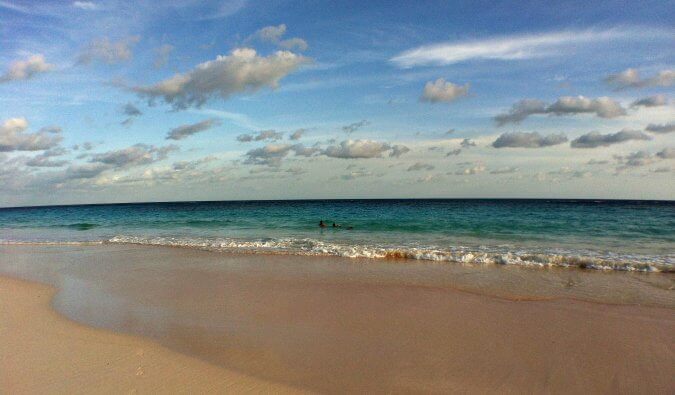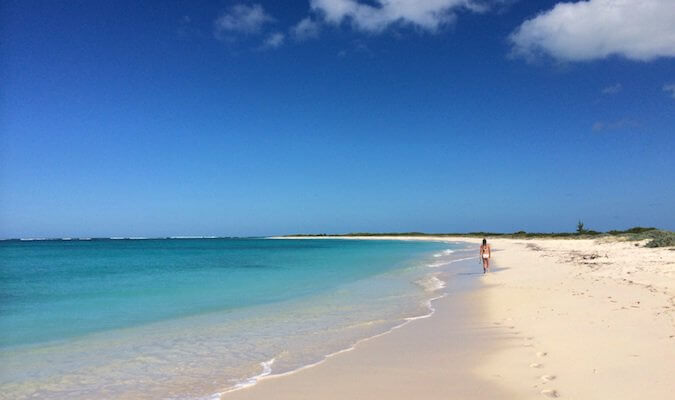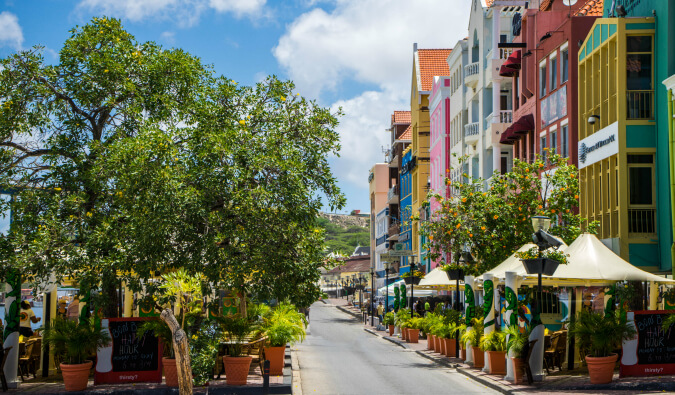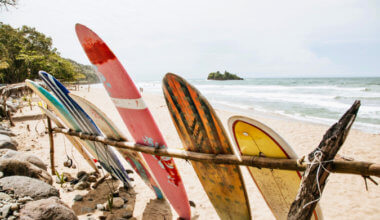Along with Aruba and Bonaire, Curaçao is one of the three “ABC” islands of the Lesser Antilles in the Caribbean.
As the largest and most populated of the Netherlands Antilles, Curaçao has the most going on and the most “social life.” It’s the hippest island in the chain and the most visited by younger travelers (it has a lot fewer resorts than Aruba).
The island’s capital, Willemstad, is a bustling city with brightly colored Dutch architecture, and its Old Town area is a UNESCO World Heritage Site. The island boasts delicious restaurants, hidden beaches, and has a lot to see and do.
That said, I didn’t love Curaçao. I liked it and I’m glad I went but I didn’t love it the way other people do. I’m more “in like” with it.
But that doesn’t mean it’s not worth visiting!
This Curaçao travel guide has all the practical information you need to help you plan your visit so you can decide for yourself whether this idyllic island is for you!
Table of Contents
Top 5 Things to See and Do in Curaçao
1. Have fun on Mambo Beach
Mambo beach, also known as “Sea Aquarium Beach,” is a lively place with tons going on. It’s the place to be in Curaçao, with beautiful sparkling shores, water sports, and tons of restaurants, shopping, and bars on the boulevard. There are plenty of nightclubs on the island but, for the craziest beach parties, go to Mambo Beach. At Wet’n Wild Beach Club, the beach is transformed into an open-air nightclub on Fridays and Sundays. Live music and DJs keep the party going, especially on Sunday nights.
2. Tour the Hato Caves
The Hato Caves are located near the airport (they are even walkable from there, or you can take a short taxi ride), these 300,000-year-old limestone caves were once hiding spots for escaped slaves, who would hide out for weeks or even months at a time. Climb up the 49 steps to reach the scenic panoramic terrace where you can enter the cave and take a 45-minute guided tour to see the stalagmites, stalactites, bat colony, and cave drawings by the Amerindian Arawaks, which date back over 1,500 years. There are trails outside to enjoy beautiful nature and wildlife on the ‘Indian Trail’ and see the carvings done by the Caiquetio Indians. Admission is 17.50 ANG.
3. Explore Willemstad
A beautiful UNESCO World Heritage Site, Willemstad is like a colorful and tropical version of Amsterdam (after all, the Dutch did colonize the island). This vibrant, artsy city was named after Dutch governor Willem II van Oranje and still has original historical buildings from the 17th and 18th centuries as well as sidewalk cafes and waterways reminiscent of Amsterdam. Both the Punda and Pietermaai areas are chock full of restaurants, galleries, and shops. And don’t miss the Old Market to try delicious local specialties like goat stew and red snapper.
4. Hike around Christoffel Park
Hit the trails around this huge national park to see deer, 10-foot-high cacti, iguanas, rabbits, and rare plant life, including wild orchids. There are many biodiverse scenic mountain and coastal trails for every ability level, including a challenging hike to the top of Christoffel Mountain. Be sure to bring enough water, snacks, and sunscreen. If you’ve got a car, there are two scenic road trails as well if you’d rather not walk but still want to appreciate the wildlife. Admission is 15 ANG, including entrance to the Savonet Museum, which has exhibits about the life of early settlers in the area on the Savonet plantation (as well as the indigenous Arawak).
5. Dive the Superior Producer
This ship sank in 1977 just 152 meters (500 feet) off the Curaçao coast. It was packed with whiskey, perfume, and clothes. Much to the surprise and delight of the local inhabitants, the contents washed up on the coast of Willemstad where people could gather up the rest of the goods. A 400-ton cargo ship, it was originally named Andromeda and was built in 1957 in Kootstertille, Netherlands. These days, the shipwreck makes for one of the most interesting dive spots around the island as the entire vessel has been taken over by coral, tarpons, barracuda, sea sponges, sea whips, and gorgonians. Two-tank dives start from 145-160 ANG.
Other Things to See and Do in Curaçao
1. Hang out on Blauwbaai Beach
Blauwbaai (Blue Bay) is the busiest beach on Curaçao, offering a wide stretch of white sand, bright blue waters, and swaying palm trees. There are also restaurants and bars along the beach, so you’re always within reach of a cocktail or a snack. It costs 15 ANG to visit, including a sun lounger.
2. Relax on Daaibooi Beach
If you find some of the more popular beaches on Curaçao too crowded, head to Daaibooi Beach. You’ll get to enjoy soft sands and a turquoise sea in relative peace. A lot of locals hang out here, and the shallow, clear water makes for good snorkeling. There’s no entry fee, and the food and drinks nearby are cheaper than at Blauwbaai. If you’re in the mood for beach hopping, other great beaches on the island include Playa Lagun, Cas Abao Beach, and Playa Porto Marie.
3. Dive the Mushroom Forest
Curaçao’s Mushroom Forest teems with marine life, including sea turtles, porcupine fish, and parrotfish. The base of the coral has been slowly eroded by waves, fish, sponges, and clams over time, creating the appearance of huge mushrooms growing on the ocean floor. A two-tank dive costs around 160 ANG.
4. Enjoy Carnival
January marks the beginning of the Curaçao Carnival when the whole island turns into a colorful celebration of friendly competitions, public parties, and street parades. The Carnival wraps up at the end of March (yes, it’s a very long party), with the burning of King Momo at midnight. The life-sized, straw-filled effigy symbolizes infertility, sins, and bad luck.
5. Kayak around the coast
A leisurely guided paddle through Curaçao’s Caracas Bay brings you to secluded beaches and historical landmarks, like Fort Beekenburg. Bring some snorkeling gear and explore the shallow waters around the coast, or chill out and soak up the sun before paddling back across the bay. Tours start from about 90-108 ANG.
6. See the Queen Emma Bridge
This long pontoon bridge in Willemstad was built in 1888 to connect the Punda and Otrobanda neighborhoods. It’s pedestrian-only and unique for its hinged structure with two propellers; the entire bridge can swing parallel to the shore so that boats can come and go out of St. Anna Bay. It’s fun to be on the moving bridge as it swings!
7. Visit Fort Amsterdam
Built in 1635, Fort Amsterdam is the oldest fort in Curaçao. It’s a UNESCO World Heritage Site and once was the island’s most important fortification. Nowadays it’s home to the governor’s house and several government offices as well as the Fortkirche, the oldest church on Curaçao. You can visit the church, which contains its original pulpit, as well as a small historical museum. It’s free to visit.
8. Tour Shete Boka Park
Shete Boka Park covers 10 kilometers (6 miles) of the island’s rocky northern coast. There are 10 secluded beaches here, several of which are home to different species of sea turtles and their nests. Boka Tabla is the most popular inlet, especially for its deep underground cave. There’s also a “secret” blow hole area located near Westpunt (the only way to get there is by off-roading). Jeep tours in the park and to the blowhole start from about 116 ANG.
9. Visit the salt flats
Called saliñas, Curaçao’s salt flats are no longer harvested for their “white gold.” Located in the former Jan Thiel plantation, this popular bleached landscape has some unique flora and fauna and it’s also a great place to see flamingos. Walking tours around the salt flats cost around 45 ANG including water and fruit and last 2-2.5 hours.
10. Take a trip to Klein Curaçao
A mere 24 kilometers (15 miles) of choppy water separates Curaçao and Klein Curaçao (Little Curaçao). This is a great day trip for snorkelers, divers, and sun-worshippers. The island is almost completely uninhabited but there are a few things its former residents left behind, including an old (but functional) lighthouse. Klein, like Curaçao, was part of the 17th and 18th-century slave trade through the Dutch West India Company, and many African slaves were buried here when they were forced to quarantine after falling ill en route to Curaçao. The white sand beach here is longer than any beach on the main island and the coral reefs, clear waters, and abundant marine life makes a visit worth the trip. Bring sunscreen as there’s not much shade. Charters cost around 180 ANG per person or an open bar cruise starts at about 215 ANG.
11. Visit the Kurá Hulanda Museum
This museum is located in the home of a 19th-century merchant and slave owner and tells the story of the African slave trade on Curaçao. The exhibits include 18th-century artifacts and scale models as well as collections of pre-Columbian gold, Mesopotamian relics, and Antillean art. It’s a humbling experience. Admission is 20 ANG. Guided tours need to be arranged in advance.
For information about other Caribbean destinations, check out these guides:
Curaçao Travel Costs
Hostel prices – A bed in a 4-6-bed dorm costs 45-55 ANG per night. A dorm with 8 beds or more isn’t much cheaper, costing about 40 ANG per night. Private rooms cost about 95-100 ANG per night for singles and 120 ANG for doubles. Free Wi-Fi and self-catering facilities are standard.
Budget hotel prices – Budget hotels start at 175-200 ANG per night. Amenities like free Wi-Fi are common, but not included everywhere. Some budget hostels also have pools.
On Airbnb, private rooms average around 100-140 ANG per night while an entire home/apartment averages closer to 235-250 ANG per night. Expect prices to double if you don’t book early.
Food – The cuisine in Curaçao is a mix of Dutch, Caribbean, African, and South American flavors. Seafood, of course, is king, with mahi-mahi, red snapper, and grouper all being commonly caught around the island. Fresh fruit is also super popular. Be sure to try keshi yena (a baked cheeseball with meat), stoba (a hearty meat stew, usually with goat), raw herring, fish tacos, fresh mussels, and oliebollen (small fried donuts).
Sandwiches, burgers, and other fast food costs between 6-14 ANG per meal. A combo meal at McDonald’s costs about 18 ANG.
A casual restaurant meal of seafood or other local cuisine costs around 30 ANG. If you want to splash out, a three-course meal with a drink at a mid-range restaurant costs closer to 65 ANG.
Beer is 5-8 ANG while a latte or cappuccino is around 6.50 ANG. Bottled water is 3 ANG.
If you plan on cooking your own food, basic groceries for one week cost about 85-125 ANG. This gets you staples like rice, pasta, seasonal produce, and some meat or fish.
Backpacking Curaçao Suggested Budgets
If you’re backpacking Curaçao, my suggested budget is around 110 ANG per day. This assumes you’re staying in a hostel dorm, cooking all of your meals, limiting your drinking, taking public transportation to get around, and sticking to mostly free activities like hanging out at the beach. If you plan on drinking, add 10-20 ANG to your daily budget.
On a mid-range budget of 325 ANG per day, you can stay in a private Airbnb, enjoy a few drinks, eat some meals out, take the occasional taxi to get around, and do more paid activities like snorkeling or diving.
On a “luxury” budget of 525 ANG or more per day, you can stay in a hotel, eat out for all your meals, drink as much as you’d like, rent a car or take more taxis, and do whatever tours and activities you want. This is just the ground floor for luxury though. The sky is the limit!
Curaçao Travel Guide: Money-Saving Tips
Costs in Curaçao can really add up if you’re not careful — but it’s not nearly as expensive as other islands in the Caribbean. Here are some of my recommended ways to save money in Curaçao:
- Stay with a local – If you plan ahead, you can usually find a Couchsurfing host in Curaçao. This is the best way to save money, as you’ll get free accommodation while also connecting with a local who can share their insider tips and advice with you.
- Have a BBQ – BBQing on the beach is a popular local activity and can help you save a lot of money on food. A lot of beaches have BBQ pits, including Daaibooi Beach. Cooking your own meals, in general, is going to save you a lot so skip the restaurants.
- Avoid the taxis – The taxis here are very expensive. They should be avoided at all costs!
- Rent a car – Getting your own set of wheels is the most economical and convenient way to get around to the far parts of the island (especially if you’re not traveling alone). Not renting one was my biggest mistake when I visited Curaçao. Share a car with other travelers to keep things affordable.
- Visit in the shoulder season – Prices can be as much as 50% cheaper for accommodation and activities, so avoid the peak season to save money (more on this below).
- Bring a water bottle – The tap water here is safe to drink so bring a reusable water bottle to save money and reduce your plastic use. LifeStraw is my go-to brand as their bottles have built-in filters to ensure your water is always clean and safe.
Where to Stay in Curaçao
Curaçao’s hostels are clean, comfy, and well-maintained. Many of them even have pools or easy access to the beach. My suggested places to stay in Curaçao are:
How to Get Around Curaçao
Public transportation – Curaçao has a public bus network, although it’s very limited. There are buses to the West End (Willemstad) departing from Otrobanda and buses to the southeast leaving Punda (also in Willemstad). Fare cost around 2.40 ANG.
Bicycle – Although Curaçao is a Dutch colony, it’s surprisingly hard to get around here on a bicycle. Expect to spend around 40 ANG per day for a bike rental (30 ANG if you rent for a week or more).
Taxi – Taxis in Curaçao are safe and reliable. Although not all of them have meters, most of them have rate sheets. They’re best for getting around Willemstad, as longer journeys cost much more. Compared to the bus, they’re super pricey so skip them if you’re on a budget!
Car rental – A car rental is one of the most economical and efficient ways to get around the island, and there are several major car rental chains at the airport. Rentals cost around 78-85 ANG per day for a multi-day rental. Drivers need to be at least 21 years of age (though some companies require you to be 23).
For the best car rental prices, use Discover Cars.
Hitchhiking – Hitchhiking is not common in Curaçao so stick to taking the bus or renting a car.
When to Go to Curaçao
December to April are the busiest months in Curaçao. This is when hotel rates are the highest and prices for activities spike. On the other hand, the water visibility is ideal for diving and snorkeling. Average daily temperatures during this time hover around 30°C (87°F).
Personally, I recommend visiting Curaçao between May-November. During this off-peak season, accommodation and activity rates are up to 50% lower than in the peak season. The beaches are much less busy during this time and temperatures are still hot and pleasant in both July and August, with daily highs soaring as high as 32°C (89°F).
Curaçao is also outside the hurricane zone, so you don’t have to worry too much about tropical storms.
How to Stay Safe in Curaçao
Curaçao is considered one of the safest places to visit in the Caribbean. It’s a small island with little crime, though petty theft can occur so don’t leave your valuables out in the open at the beach (or anywhere) just to be safe.
Solo female travelers should generally feel safe here, however, the standard precautions apply (never leave your drink unattended at the bar, never walk home alone intoxicated, etc.).
Scams here are rare, but if you’re worried about getting ripped off, you can read about common travel scams to avoid right here.
As with the neighboring “ABC” islands, hurricanes are rare here and shouldn’t be a major concern like elsewhere in the Caribbean.
If you experience an emergency, dial 911 for assistance.
The most important piece of advice I can offer is to purchase good travel insurance. Travel insurance protects you against illness, injury, theft, and cancellations. It’s comprehensive protection in case anything goes wrong. I never go on a trip without it as I’ve had to use it many times in the past.
Curaçao Travel Guide: The Best Booking Resources
These are my favorite companies to use when I travel. They consistently have the best deals, offer world-class customer service and great value, and overall, are better than their competitors. They are the companies I use the most and are always the starting point in my search for travel deals.
- Skyscanner – Skyscanner is my favorite flight search engine. They search small websites and budget airlines that larger search sites tend to miss. They are hands down the number one place to start.
- Hostelworld – This is the best hostel accommodation site out there with the largest inventory, best search interface, and widest availability.
- Booking.com – The best all around booking site that constantly provides the cheapest and lowest rates. They have the widest selection of budget accommodation. In all my tests, they’ve always had the cheapest rates out of all the booking websites.
- Get Your Guide – Get Your Guide is a huge online marketplace for tours and excursions. They have tons of tour options available in cities all around the world, including everything from cooking classes, walking tours, street art lessons, and more!
- SafetyWing – Safety Wing offers convenient and affordable plans tailored to digital nomads and long-term travelers. They have cheap monthly plans, great customer service, and an easy-to-use claims process that makes it perfect for those on the road.
- LifeStraw – My go-to company for reusable water bottles with built-in filters so you can ensure your drinking water is always clean and safe.
- Unbound Merino – They make lightweight, durable, easy-to-clean travel clothing.
- Top Travel Credit Cards – Points are the best way to cut down travel expenses. Here’s my favorite point earning credit cards so you can get free travel!
Curaçao Travel Guide: Related Articles
Want more info? Check out all the articles I’ve written on backpacking/traveling the Caribbean and continue planning your trip:
9 Ways to Explore the Caribbean Sustainably
My 16 Favorite Things to Do in the Virgin Islands
Bermuda: The Impossible Budget Destination? Maybe Not!
How to Save (and Not Save) Money in the Virgin Islands
I Didn’t Like Curaçao (But I Didn’t Hate it Either)
The Best Places on Costa Rica’s Caribbean Coast
